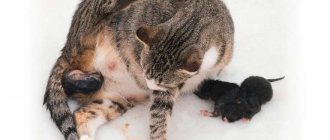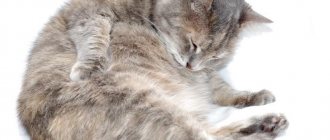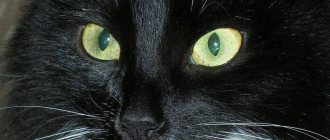On average, a cat reaches puberty between 5 and 12 months of age. In rare cases, a cat may become ready to conceive at 3.5 months. For other females, the maturation process may be delayed until they are 18 months old. If your cat has not started to come into heat after a year and a half, she needs to be seen by a veterinarian.
The following factors influence the age of puberty:
- weight;
- health status;
- conditions of detention;
- season;
- length of daylight hours;
- breed;
- heredity.
Often, in short-haired breeds, maturation occurs earlier - by 6 months, while long-haired breeds become ready for conception only at one year of age.
The cat's readiness to mate is marked by the onset of the first heat. During this period, the animal's behavior changes significantly.
Signs of estrus:
- The cat takes an unusual pose: it presses its front paws to the ground and raises its butt.
- The female cannot find a place for herself, walks all over the house and meows desperately.
- Refusal to eat.
- Insistent attention towards the owner, or vice versa, complete ignoring of him.
Although a cat can become pregnant during her first heat, her body is not yet fully prepared for such stress. Experienced breeders allow a female to be bred only on her second or third heat.
Breeders allow domestic cats to breed until the age of six. In rare cases, breeders also work with older cats for selection purposes. Since pregnancy at this age is associated with serious risks, only animals that are valuable for breeding (for example, an unusual phenotype) are allowed for breeding.
Caring for a pregnant cat
The health of the furry offspring largely depends on how its owners will care for the pregnant cat.
First of all, you should pay attention to the diet of the expectant mother. If before conception you fed your kitty dry food, then gradually switch to special food for pregnant animals
They contain much more vitamins that are so necessary for the cat during this period.
Those who are accustomed to feeding their cat from their table, that is, natural food, should consult a veterinarian about taking vitamin and mineral complexes. But you shouldn’t get carried away with them - an excess of certain substances in an animal’s body can do more harm than good and cause the development of various kinds of pathologies in kittens. Not only the menu will have to change, but also the feeding schedule. A pregnant cat should add food to its plate more often, about 5 times a day, but in smaller portions.
It is impossible to carry out anthelmintic prophylaxis and vaccinate cats in this state. These points must be taken care of before mating. As for the fight against external parasites (fleas, ticks, lice eaters), it is not only possible, but also necessary to fight them. The main thing is to use products that do not contain pesticides (for example, stronghold).
Important! If there are small children in the house, warn them that under no circumstances should a cat expecting kittens be lifted by hugging its belly and squeezed in a tight hug!
The most necessary things for the birth of your pet
A cat needs a comfortable and private place to give birth. Therefore, the owner must prepare a large, comfortable box or bed. It is best to do this a week before the expected birth. The place must correspond not only to the size of the animal, but also to accommodate several kittens. The place for childbirth must be completely clean.
In order to give birth at home, you will need the following necessary things:
- Special absorbent diapers. They will be needed not only during childbirth, but also in the next two days.
- Clean and ironed fabric. You will need it the same day to dry the kittens.
- At the time of birth, you will need a clean towel to wrap the little kittens.
- Disinfectant for hands and scissors.
- A special medical instrument for suctioning fluid from a baby’s nose.
- Zelenka.
- A heating pad for keeping babies warm.
- The owner of the animal can purchase the drug Travmatin. It has an analgesic effect and helps regulate the strength of contractions. It can be used to eliminate postpartum complications. Travmatin pricks during contractions and after the birth of kittens for several days. Kittens receive dripping immediately after birth.
If the duration of a cat's labor is longer than expected, you should immediately consult a specialist and find out how to help your pet. Better yet, take your cat to a veterinary clinic.
In the end, I would like to note that a furry pussy can become pregnant several times a year. Get ready to welcome a big furry family!
Planning a cat's pregnancy
If you plan to breed a purebred cat, you should find out in advance whether the resulting offspring will improve the breed (or at least not significantly worsen it). In the case of irresponsible crossing of purebred cats, the appearance of animals becomes more frequent, not only outwardly not meeting breed standards, but also with changes in the skeletal structure that make life difficult for cats, hereditary diseases, and sometimes even a tendency to aggression is transmitted. Find out in advance from your veterinarian what hereditary diseases cats of the same breed as yours are prone to, and conduct the appropriate research to protect future offspring from trouble.
If you decide that the risk justifies the appearance of kittens, and in the case of breeding purebred animals, you find out that your beauty’s family consists of healthy offspring, then to ensure safety, you need to plan everything carefully. For both outbred and purebred cats, there is a danger of contracting some serious infectious diseases during mating. Therefore, veterinarians do not recommend that even outbred animals become pregnant from mating with an “unknown gentleman”; it is better if the male with whom mating is planned has been tested for such infections, has been treated for worms, vaccinated with a complex vaccine and has undergone a general examination by a veterinarian.
Signs of cat pregnancy
The female is ready for procreation most often from the 7th month of life. However, there is no need to rush into mating; the cat’s young body needs to get stronger and mature a little more. The optimal period for the first mating is a year.
Best articles: List of the best and most beautiful national parks on Earth
The first signs of a cat’s pregnancy appear after 2.5-3 weeks:
- nipples acquire a pinkish tint and swell;
- a noticeable decrease in the pet’s activity;
- morning vomiting is an indicator of hormonal changes;
After 2-3 weeks, the animal regains its appetite. The veterinarian performs palpation on the 20th day. You should not do this yourself because of the high possibility of harming both the future kittens and their mother.
At the 4-5th week of a cat’s pregnancy, weight gain becomes obvious: +1-2 kg. Weight depends on the number of future offspring. The cat becomes more wary of strangers and more affectionate towards her family.
The taste preferences of the expectant mother change, and you may notice mood swings.
After 6 weeks, a large belly becomes noticeable, the animal’s movements slow down, and its gait may change. Starting from the 7th week, the cat is looking for a “nest” and may begin to get nervous. Milk appears in the mammary glands at the beginning of the ninth week.
The birth itself begins with contractions, the whole process takes less than a day, usually 3-4 hours. After contractions and pushing, the fetus will appear in the bladder. The animal gnaws the umbilical cord and may eat the afterbirth. After this, the newborn kitten begins to eat, and the mother continues the birth process.
How to determine the gestational age of a cat
A gradually enlarging belly makes the owner nervous, which can also be felt by the pet.
It’s better to know exactly how far along your cat’s pregnancy is in order to properly prepare for the important event.
The period is determined by the external signs that the cat’s body shows. On days 16-18, the nipples become a bright coral color.
An increased appetite affects the pet’s weight, but you need to make sure that this is a consequence of an interesting situation, and not the presence of parasites in the body. If in doubt, contact a veterinarian and do an ultrasound on the cat during pregnancy, which is determined from the 15th day after fertilization.
If previously the doctor could simply feel a certain number of fetuses in the animal’s stomach, then from the 40th day the veterinarian will tell you the exact number of expected kittens.
It is convenient to use an online calculator, which will calculate the most accurate gestational age for your cat.
Cat birth: course and assistance
You can deliver a cat yourself without the help of a veterinarian. In rare cases, difficult births may occur; pathologies are even less common. To avoid unnecessary hassle, you need to prepare the items needed for childbirth . To do this, you will need a heating pad with hot water, a towel and sterilized scissors.
When born, kittens are surrounded by amniotic sac and connected by an umbilical cord and placenta. The umbilical cord is chewed by the cat, she also eats the afterbirth and licks them with her tongue to clean newborns of mucus. The interval between the birth of kittens is 30-50 minutes, however, temporary changes are possible depending on the physiological structure of the animal and the number of offspring. The longest labor can last over 20 hours. It is recommended to call a veterinarian if prolonged and strong contractions are observed, but labor does not occur; or there was a delay in time between the birth of kittens.
There are several signs that indicate that the birth process may be difficult. This may be bleeding before labor begins. In this case, it is better to consult a doctor to avoid possible complications. The cat may be restless and refuse its maternal duties after the end of labor (cessation of contractions). In this case, one of the kittens could remain in the pet's stomach. Timely assistance from a specialist will help avoid an unfortunate outcome.
How to help a cat give birth
If a person has even a slight understanding of veterinary medicine, he can ease the birth pangs of an animal.
- For example, in a situation where the intensity of contractions decreases, you should give the cat a massage in the abdomen and back.
- In a situation where the cat has not chewed the umbilical cord, you should tie the canal connecting mother and child with thread at a distance of 1 cm from the kitten’s body, then cut the umbilical cord, stepping back from the tied place by a centimeter.
- If the kitten is stuck in the birth canal and is only half visible, you can wrap it in a towel or thick cloth and try to pull it out. This manipulation should be carried out with extreme care and caution.
- After removing the baby from the womb, it is necessary to get rid of the amniotic sac, clean the mouth and stimulate the process of breathing and blood circulation by rubbing.
- When the contractions end, labor will also end. To be completely sure that labor is over, the owner must feel the cat’s belly and make sure that there are no more kittens in the womb.
- After giving birth, the cat can be given the required dose of oxytocin. This remedy will eliminate the possibility of adverse consequences, including inflammatory processes.
After the birth of kittens, the owner may be puzzled by the question of how to find out the gender of the kittens . The answer can be obtained during the examination of the babies. At birth, kittens are deaf and blind. After approximately 1.5 weeks, the eyes begin to open, and over the next seven days it becomes possible to see normally. The rumor appears a little earlier.
From birth, kittens have senses of smell and touch. This is what helps them find their mother and navigate space. The mother cat communicates with her babies through her voice. The kittens move by crawling on their stomachs, pushing off with their paws. The cat is separated from the kittens only when natural needs arise.
Behavior of a new mother
Immediately after the birth, the cat collects the kittens under her tummy and feeds them. In the first few days after birth, it is not milk that is released from the mother cat's nipples, but colostrum , as in all mammals. It differs from milk in composition, contains immunoglobulins and antitoxins that protect the newborn, and also normalizes the activity of the digestive tract. It is very important that babies eat well and receive enough colostrum in the first days after birth.
As soon as the kittens have eaten, the cat begins to tidy up the nest and herself. You can help her with this and re-lay the bedding. The cat warms the kittens with her warmth; she gathers the kittens under her tummy and head, so that everyone is warm. In the first days, it is also advisable to control that the new mother does not accidentally run over anyone. In the first days after birth, the cat practically does not leave the kittens; she constantly feeds them and warms them, leaving only in cases of extreme necessity, when the babies have eaten and released their nipples.
It often happens that a few days after giving birth, a cat decides to change the nest and looks for a more comfortable place for the kittens, so at night she can bring the kittens to the owners under the blanket to help protect the babies.
This is an instinctive feature left over from wild ancestors who changed the nest: after all, the smell of blood and amniotic fluid can give the nest away to predators. In this case, you can change the bedding to clean ones, change the configuration of the nest, make it more like a mink, with a small entrance, cramped and dark, or even re-equip the nest in a new place. It is not advisable to make a nest at a height, on your bed, because at 3 weeks the kittens will begin to crawl out of it and may fall from a height.
Too much nervousness and fussiness in a cat may indicate eclampsia , so pay close attention to the cat’s behavior. If remodeling the nest doesn't help and your cat is fussing too much, consult your veterinarian.
While the kittens feed only on milk, the mother cat licks them thoroughly, thereby stimulating the functioning of the gastrointestinal tract and excretory organs. Once the cubs begin to eat solid food, be it meat or special cat food, they can be trained to go to the litter box. Mom will wash them only to maintain cleanliness.
Caring for a pregnant cat:
To feed a pregnant cat, you need to use special food for pregnant women; proper feeding will help future kittens develop well. 3-4 days before birth, it is advisable to do an ultrasound to determine the number and size of the fetuses - this will help predict the course of pregnancy (sometimes the kittens are too large - in this case the issue of surgery is decided).
Best articles: On what continent is the country of Mexico located?
Throughout pregnancy, you need to protect the cat from overheating and hypothermia, handle it carefully, and do not allow strong hugs from household members, especially children. If your cat is a fan of climbing to the top of cabinets, then try to limit her jumping to low surfaces to avoid falling.
For the birth and subsequent feeding of kittens, it is necessary to prepare a room - agree with the household that in the room where the cat and kittens will be, there is no need to make noise or perform manipulations that frighten the cat (for example, do not vacuum). To make a “nest” for a cat, you can take an empty cardboard box or use an old bedside table, or make a “plywood maternity hospital” yourself. The large hole for the cat to pass through should be sized to accommodate the fact that a pregnant cat will climb into it; this hole should be located at some distance from the floor so that the kittens, starting to crawl, do not leave the box too early.
Preparing for childbirth
1–2 weeks before giving birth, the cat will begin what is called nesting. Usually, from the 7th week of pregnancy, the pet begins to look for a convenient shelf in the closet or other shelter that will become a nest. During this period, it is strictly forbidden to let the cat go for walks, as it may set up a nest outside the house.
Carefully monitor your pet's behavior and do not interfere unless absolutely necessary. If your cat decides to build a nest in your closet, it is wiser to empty the shelf for her than to move the nest to a more convenient place for you. It is necessary to pay attention to the preparation of the nest, if only because the cat can give birth on your bed, clothes or a stack of clean laundry.
Important! During the process of giving birth and feeding the offspring, the cat must be protected from stress as much as possible.
You can avoid negative consequences if you prepare the nest for birth yourself. Stores sell special boxes that are equipped with nests for women in labor. In fact, any sturdy cardboard box with high sides will do.
One wall is cut off, leaving a side that the cat can easily step over. When preparing the nest, it is better to stock up on an extra box, since during birth the cardboard may get wet and tear.
Important! Before making a nest out of a box, make sure that it is not fastened with sharp staples or glued with toxic substances.
Think in advance about how to close the top of the box so that the cat feels private and calm. A few days before giving birth and the onset of contractions, most cats become withdrawn and try to hide. For an expectant mother who will give birth for the first time, it is better to equip several nests at once. Before giving birth, the pet will choose a more optimal and safe (from her point of view) place.
Cat pregnancy
Animals have a strong reproductive instinct, but it turns on not just when, but precisely on the most suitable days for conception. Smart nature took care of the continuation of the feline race, so in the life of pets there is a “sexual season”, called the estrus period. A cat can become pregnant about once every three weeks—the body gives the owner’s pet a chance to become a mother.
Few people can resist tiny kittens, especially if they are babies from their favorite cat. The time when the babies begin to run around the house is preceded by a fairly long period of pregnancy and the birth process. An attentive owner must understand all the difficulties of the gestation period, the health of the pet and the nuances of caring for the expectant mother.
Signs of pregnancy in a cat:
The first signs that a cat is pregnant begin to appear approximately 3 weeks after fertilization - increased weight and appetite, increased size and increased pink coloration of the nipples. Until this time, the animal is often the opposite, less active, appetite and activity may be reduced, which often leads owners to false conclusions about a possible disease. Starting from 2-3 weeks, a cat’s pregnancy can be confirmed by ultrasound.
At 4-6 weeks, palpation can already detect the fetus, but it is not advisable to palpate the abdominal cavity of a pregnant cat yourself - careless movements can lead to miscarriage. At the 6th week, a pregnant cat’s rounded belly is already clearly visible. By the 7th week, you can already observe fetal movement, mammary glands enlarge, and sometimes you can observe a small amount of milky discharge from the vagina.
Best articles: TOP 5 parasites that turn insects and animals into zombies
The average duration of a cat's pregnancy is 9 weeks; usually, by the end of this period, cats become less active and calm, and before giving birth, on the contrary, activity increases, the animal begins to actively look for a place for a “birth nest” and ask for affection from the owner. These changes in behavior can begin 3-4 days before birth, but sometimes just before the birth itself, so it is worth being alert for these signs.
False pregnancy in a cat
Usually, after mating, the cat becomes pregnant
The behavior of the pet and some signs confirm the interesting position of the animal: swelling of the mammary glands, caution of the female in behavior, enlargement of the abdomen. But after 3 or 4 weeks all symptoms disappear
This is called a false pregnancy, which is actually a hormonal imbalance in the cat's body. This negatively affects the animal's psyche.
The reasons for the occurrence of false pregnancy lie not only in hormonal imbalance: perhaps the mating was with a sterile cat, or the female’s body has pathologies of the reproductive system, disorders of the thyroid gland.
Treatment includes a diet and a reduction in the amount of dairy products in the pet’s menu, which will have a positive effect on the cat.
It is important to show attention to the injured cat and surround it with care. It is advisable to add vitamins to food
Injections for cats from pregnancy
Not all owners want to get offspring from their pet. To prevent cat pregnancy, special injections have been developed, prescribed according to a regimen selected by the veterinarian.
The injection is given before the onset of estrus, and the effect of the hormonal agent is effective for 6 months. Afterwards, a new dose of the drug will be required.
This is a kind of sterilization, simple to use, and leaving the cat the opportunity to bear offspring after the drug wears off.
This method has disadvantages: dysfunction of the reproductive system, health complications including inflammation and cancer.
Energy and dynamism of expectant mothers
After a cat becomes pregnant, the animal forgets about active play during pregnancy. But there are also exceptions. Some pets lead an active life despite their impressive belly. The cat should not sleep and lie down all the time, this will quickly cause it to gain weight. The owner needs to play with the expectant mother, thereby forcing her to move. The load should be chosen that is optimal for the cat’s position, and the games should be harmless.
The owner must monitor the condition of his pet at all times. Any dangerous symptoms indicate a pregnancy disorder.
Pregnancy in cats
Personally, at this stage, fate has rewarded me with two male furry paws, so the happiness of cat motherhood does not threaten me. But this is not a reason not to understand the intricacies of the feline process of pregnancy and reproduction.
Usually, owners of domestic cats sterilize to avoid possible pregnancies, not to bother with the distribution of kittens, and to save the cat from suffering and diseases associated with the feline reproductive system.
But if you are sure that your “valuable fur” has unique characteristics of nature and breed and you really want striped, furry grandchildren, then it is better to approach the issue of cat pregnancy with all responsibility.
Pet immunization
Cat pregnancy is the main contraindication for boosting immunity with vaccines. You should think about this for several months before mating. If the owner does not vaccinate the cat on time, this procedure is performed a few weeks after the kittens appear. But you should pay attention to what condition the animal will be in.











